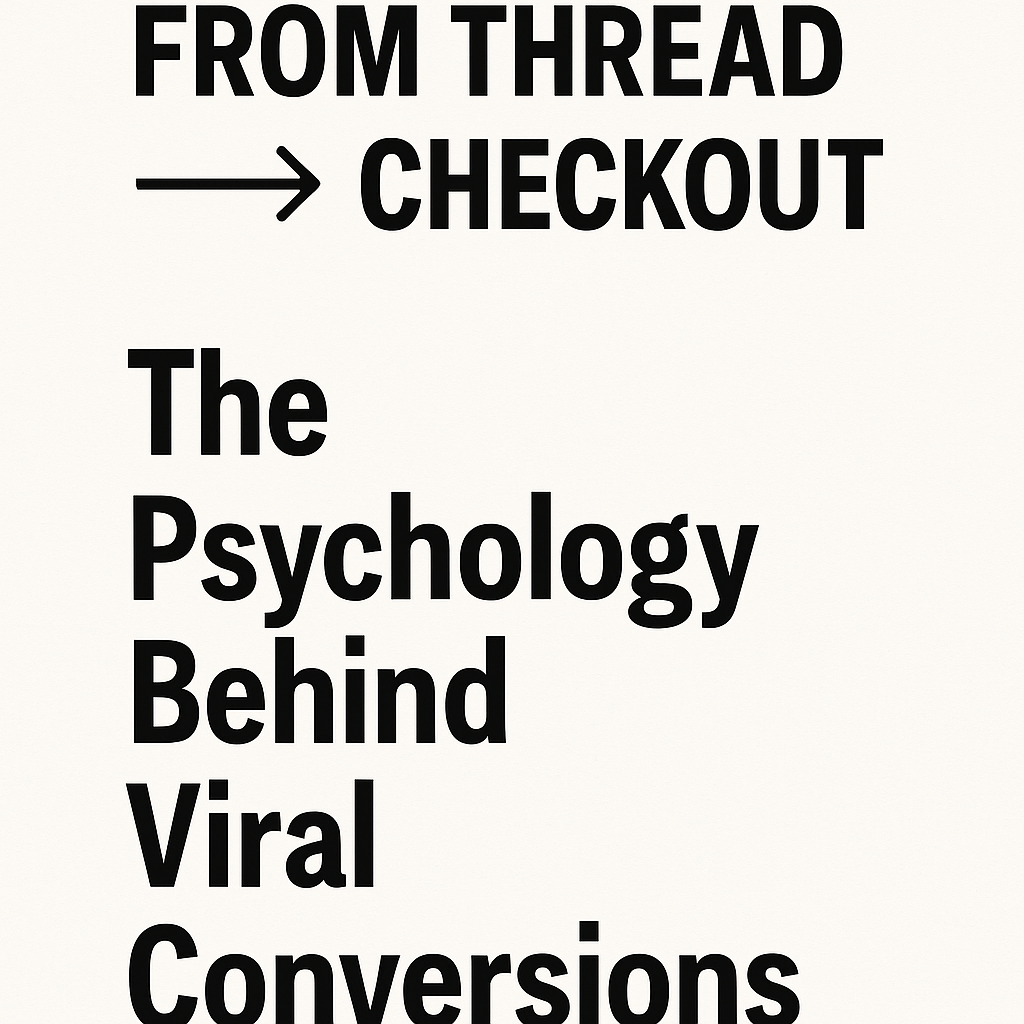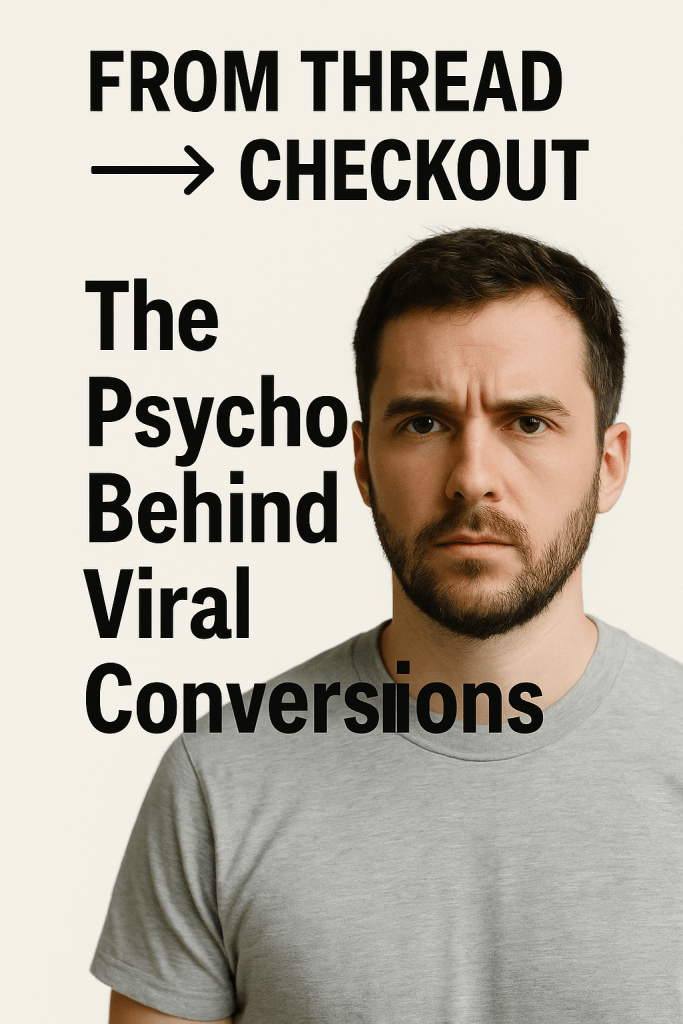- Ark's Newsletter
- Posts
- From Thread to Checkout: The Psychology Behind Viral Conversions
From Thread to Checkout: The Psychology Behind Viral Conversions
Introduction
You’ve seen it before: a Threads post explodes with engagement, racking up hundreds (or thousands) of comments. But very few of those engaged users become customers. That gap is the chasm most creators struggle to cross.
In this article, you’ll learn the psychology and tactical architecture behind converting a scroll-stopper thread into an actual sale—in a way that feels natural, not pushy. By the end, you’ll understand why people comment, how comments turn into permission, and how to channel that permission into a checkout for your digital products (Notion templates, Canva kits, eBooks, spreadsheets, etc.).

Why Threads Can Be a Conversion Goldmine
1. Low Barrier to Entry
Threads is designed for short, conversational posts. That means more people read, engage, and respond—increasing your exposure and reach.
2. Engagement = Visibility
On many platforms, comments and saves carry more algorithm weight than “likes.” When your thread invites interaction, each reply amplifies your reach.
3. Real Conversations vs Broadcasts
Threads encourages reply chains. Unlike a one-directional ad, you can talk with your audience. That’s emotional connection—and emotional connection fuels buying decisions.
4. Trust via Value
Because people consume your content directly and hear your voice (style, tone, and personality), they perceive “you” as a person, not a faceless brand. That trust primes them to buy.
The Conversion Gap: Where Most Threads Fail
Before we dive into solutions, it’s useful to understand where the breakdown happens in most threads:
To bridge that gap, you need a psychological flow that maps to your funnel stages.
The 4-Stage Conversion Flow (Psychology + Tactics)
Below is a funnel tailored for Threads, combining psychological principles and tactical steps.
1. Hook → Curiosity (Attention + Intrigue)
You need to grab attention and spark curiosity in your first post(s). Use techniques like
Contrarian statements (“Why X is a lie”)
Surprising statistics or outcomes
Mini-case teasers (“From $0 → $5,000 revenue in 30 days”)
Why it works:Humans avoid boredom. A hook that breaks pattern forces a pause. Once the scroll stops, curiosity takes over.
2. Content → Value + Framing (Interest + Trust)
In subsequent posts, deliver micro-lessons, stories, and frameworks—short, digestible, and actionable. Your objective:
Show you know the problem
Demonstrate your method
Reveal a bit of your personality
Tactic: Use “micro-reveals”—each swipe or post reveals 1 insight but leaves a key piece unrevealed to prompt further engagement or continuation.
3. Emotional Bridge → Permission (Desire → Openness)
Before you ask someone to buy, you must earn permission. This is the psychological pivot. You do this via comments and replies:
4R Method (Recognize, Reflect, Reframe, Route)
Recognize: acknowledge their comment
Reflect: re-state their goal or pain
Reframe: offer a fresh angle
Route: “If you reply ‘KIT,’ I’ll DM a mini version to you.”
Use keywords/gates: invite users to comment a word to unlock a swipe file, mini-kit, or preview (gives you warm leads)
This step turns strangers into conversational potentials.
4. Soft Conversion → Checkout (Action)
In the DM funnel (or email), your task is to gently lead them to act without harsh selling:
Permission is ask (“Mind if I send you the mini PDF?”)
Deliver free value (a micro-asset)
Ask a qualifying question (“Which tool do you use?”)
Offer the full product with incentives (bonus, early bird, discount)
Use urgency or scarcity sparingly
Tactic: limit your hard offer to just 1 path. Offer clarity, not confusion.
Example Thread Walkthrough
Here’s a mini example (for a Canva template seller) to illustrate the flow:
Headline / Hook (Post 1):
“I built a 3-slide Instagram carousel that made $800 in 24 h. Here’s how.”
Posts 2–6 (Value + Story):
Post 2: baseline— “I had 0 sales in 30 days before this.”
Post 3: leverage 1 (template + layering)
Post 4: leverage 2 (repurposing)
Post 5: leverage 3 (bundle + bonus)
Post 6: objection handle (“But templates seem saturated—here’s how I avoid that”)
Post 7 (Call to Action + Gate):
“Want the full carousel template and copy guide? Comment ‘KIT,’ and I’ll DM it to you.”
Comment Reply Example (4R):
User comment: “But I’m not good at design.”
Reply:
“Great point—most beginners feel stuck there.
You want to create visual assets without hiring a designer.
Instead of mastering design, lean on smart templates and tweakable defaults.
If you reply ‘KIT,’ I’ll DM you a sample set to test today.”
DM Flow (sample):
Permission request: “Here’s the starter kit I promised—okay to send it now?”
Deliver kit
Ask: “Which tool do you use—Canva or Figma?”
Based on the reply, send a mini screenshot/sample.
Soft offer: “If you want the full bundle (30 templates + guide), here’s a special link with 20% off (valid for the next 48 hours).”
SEO Optimization Elements (for your blog)
Primary keyword: “thread to checkout,” “Threads funnel,” “conversions on Threads”
Secondary keywords: “selling digital products on Threads,” “comments to customers,” “ChatGPT thread sales system”
Use the primary keyword in the title, first paragraph, 1–2 subheadings, and the URL
Include internal links (if you have related guides) and external references
Use short paragraphs, bullet lists, bold important phrases
Add alt text to images when you publish
Common Objections & How to Handle Them
Metrics to Track & Iterate
Impressions/reach
Comments
Replies asked for “KIT” or keyword
DMs initiated
Lead magnet downloads
Clicks / conversions
Sales/revenue
Use a simple spreadsheet or tool like Airtable/Notion to log metrics weekly. Over time, you’ll see which hooks, formats, or responses convert best.

Final Thoughts
Converting from Thread to Checkout isn’t magic—it’s architecture. It’s the right sequence of emotional cues and permission-building moves. If a thread goes viral but doesn’t convert, the missing link is often the middle steps you forgot: the value that primes, the comment permission system, and the soft bridge to action.
When you map your content intentionally, speak to real problems, and use comment-to-DM psychology, your Threads can become a live, free funnel doing sales work for you—even while you sleep.
Turn Your Threads Into a Conversion Engine
If you’re ready to turn your Threads posts into a powerful, repeatable marketing funnel—without guesswork—grab the Threads → Digital Product Funnel Playbook.It’s a complete, ready-to-use system packed with AI prompts, comment-to-customer frameworks, batching workflows, and proven sales templates built specifically for Notion templates, Canva designs, eBooks, and digital products.Whether you’re starting from scratch or optimizing your content funnel, this guide will help you turn engagement into income—step by step.
Keep Your Creator Space Organized & Focused
A clear desk helps you create clear ideas—and consistency on Threads starts with a focused workspace. Two beautifully minimal organizers can instantly upgrade your setup:The Wisuce Desk Organizer with Drawers combines bamboo warmth with modern white drawers—perfect for bills, notebooks, and your everyday tools.For a compact yet stylish alternative, the Bamboo Desk Organizer With Drawers Countertop Storage Box keeps pens, cables, and digital accessories in order without taking over your desk.Both arrive fully assembled, blend with any workspace aesthetic, and help keep your mind (and your funnel-building energy) clutter-free.